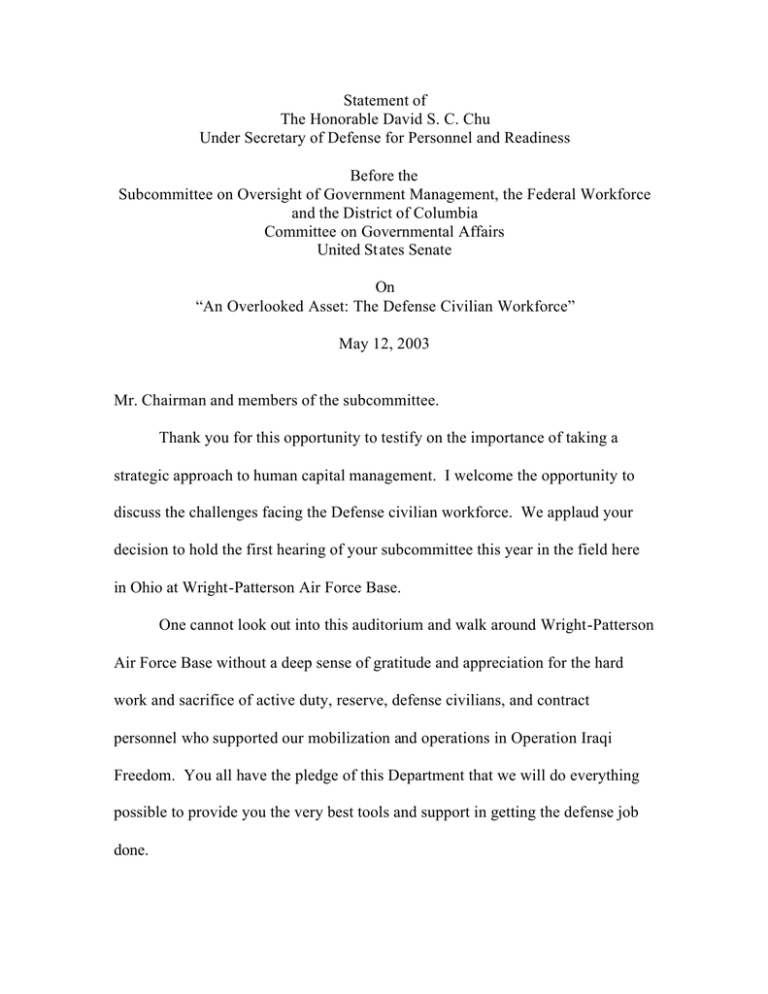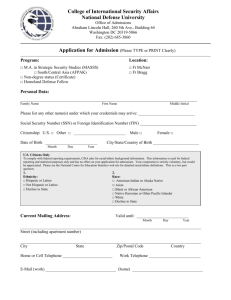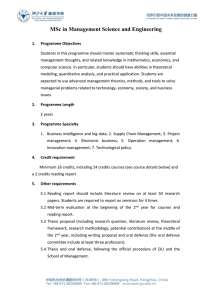Statement of The Honorable David S. C. Chu
advertisement

Statement of The Honorable David S. C. Chu Under Secretary of Defense for Personnel and Readiness Before the Subcommittee on Oversight of Government Management, the Federal Workforce and the District of Columbia Committee on Governmental Affairs United St ates Senate On “An Overlooked Asset: The Defense Civilian Workforce” May 12, 2003 Mr. Chairman and members of the subcommittee. Thank you for this opportunity to testify on the importance of taking a strategic approach to human capital management. I welcome the opportunity to discuss the challenges facing the Defense civilian workforce. We applaud your decision to hold the first hearing of your subcommittee this year in the field here in Ohio at Wright-Patterson Air Force Base. One cannot look out into this auditorium and walk around Wright-Patterson Air Force Base without a deep sense of gratitude and appreciation for the hard work and sacrifice of active duty, reserve, defense civilians, and contract personnel who supported our mobilization and operations in Operation Iraqi Freedom. You all have the pledge of this Department that we will do everything possible to provide you the very best tools and support in getting the defense job done. It is most appropriate that we discuss these matters in a place that celebrates the hundredth anniversary of powered flight this year. For we also seek a new vehicle of personnel management to take our defense civilian workforce into the new century. But, we are ready for much more than short flights, as I hope to demonstrate in my testimony. That new vehicle we call, the National Security Personnel, or NSPS, which I will describe in greater detail later. You have entitled your hearing, “An Overlooked Asset: The Defense Civilian Workforce.” We cannot often enough remind ourselves of the tremendous contribution our civilian workforce makes to the mission of this Department. That application is shared by our Secretary of Defense, Don Rumsfeld. In my experience, I have never seen a more intense commitment by a Secretary of Defense to improving the management of Defense civilians. I think you will see that the remarks I am about to give reflect the great value that this Secretary and his entire staff place on our civilian workforce. I wish to begin these remarks by recounting the experience of employees in the Department of Defense with the civilian personnel system as it now stands: • Supervisors at Fort Riley, Kansas, had to send mammography cases to local hospitals for over half a year because they could not successfully recruit a radiologist. The installation had to advertise the position more than once--and then had to assist the only person interested through the 2 recruitment process. The recruitment started in January and ended in August. • Tobyhanna Army Depot in Pennsylvania has problems recruiting engineers for communications-electronics systems mission because of inflexibility in starting grade and salary. • At Walter Reed Army Medical Center in Washington, D.C., recruitment and retention of licensed practical nurses is extremely difficult. Without a better system of recruitment and pay banding they will not be able to hire and keep a quality workforce. This is the medical staff you recently saw on television taking care of our wounded soldiers from Operation Iraqi Freedom. An Army Program Executive Officer tells us “We’ve encountered this problem when recruiting professional engineers at the GS-12 level and secretaries at the GS-6 and GS-7 levels. Generally, we have to sit the applicant down and explain exactly what to do in order to give them a chance of appearing on a certificate, because left on their own, they have no idea what to do and either apply incorrectly or give up.” These examples focus primarily not on the failed mechanisms of our personnel management system—much as they need attention—but on the threats to mission accomplishment and morale that arise from the rigidities of our 3 personnel management system. These examples are but the tip of an iceberg of disappointment with the inflexibility of the current personnel system. At the same time, the rigidities of the title 5 system of personnel management make it difficult for our civilians to support our military. In the Iraqi theater of operation, only 1,700 of the 11,000 civilians supporting the effort are Defense civilian employees. The rest are contractors. We should have the flexibility to identify, deploy, and sustain more of our civilian workforce in these operations, when necessary. We now have some 320,000 military personnel performing tasks that could be civilianized. The question is whether these jobs go to contract or federal employees. It is difficult to offer these jobs to federal employees when the current title 5 personnel system does not provide the needed flexibility to pay, reward, or assign people appropriately. Our answer is to ask Congress for authority to implement a more flexible system of personnel management, as the National Security Personnel System, grounded in the merit principles of the civil service. The shortcomings of the title 5 personnel system have been identified by one major review after another: the Office of Personnel Management in its white paper on “A Fresh Start for Federal Pay: The Case for Modernization,”; by The National Commission on the Public Service (popularly known as the Volcker II Commission) in its January, 2003 report, “Urgent Business for America: Revitalizing the Federal Government for the 21st Century,”; and in testimony before your subcommittee, Mr. Chairman, last year, by former Secretary of 4 Defense James R. Schlessinger and Admiral Harry D. Train (USN, Ret.) representing the U.S. Commission on National Security/21st Century, which was co-chaired by former Senators Gary Hart and Warren Rudman. In his testimony, Dr. Schlessigner stated “it is the Commission’s view that fixing personnel problems is a precondition for fixing virtually everything else that needs repair in the institutional edifice of U.S. national security policy.” The Commission observes: “highly qualified and talented people are not inclined to wait in uncertainty for a year or more while the government makes up its mind when they can be working at equally rewarding private sector jobs in a week or two. We simply have to make the government act smarter in the process of employing people.” Dr. Schlessinger’s testimonies continue: “the aging problem is especially acute. The first of the post-World War II baby-boom generation turns 55 (in the year 2001)…. This wave (of retirement eligibles) is exacerbated by the small numbers of employees in their twenties and thirties in most agencies. When agencies such as the Department of Defense and those within the intelligence communities chose to downsize through hiring freezes, they contributed inadvertently to this trend….The Commission believes these problems can be turned into opportunities to adapt the civilian force to meet the new challenges of the 21st century if recruitment hurdles are eliminated, if the hiring process is made faster and easier, and if professional education and retention programs worthy of full funding by Congress are designed.” 5 The Congress has recognized these shortcomings by advancing the cause of flexibility and competitiveness in the Department of Defense civilian human resources management. Congressional action paved the way twenty years ago for the groundbreaking work in pay banding at the Navy’s China Lake facility. The Congress also enacted the first federal program of separation buyouts that transformed a reduction in force into voluntary departures, authorized critical personnel demonstration projects in the defense acquisition workforce and in defense laboratories and testing centers, provided flexibility in paying for degrees, and created scholarships to attract, advance, and keep those with information assurance skills. DoD has been engaged in civilian personnel reforms through the administrations of the last three Presidents. Our proposal for a National Security Personnel System is in line with the changes effected—largely by the Congress—over the last 12 years: • In 1990, we decided that we needed to streamline the civilian personnel processes and regulations in the Department. That process resulted in the personnel efficiencies study, consolidating a major portion of the civilian personnel work being done above the operating level. • The National Defense Authorization Act of (NDAA) of 1990 established the defense acquisition workforce. • The 1992 NDAA provided authority to pay a voluntary separation incentive pay for up to $25,000 to encourage workers to leave the workforce instead of going through the reduction in force process. • In December, 1992, the Department issued Defense Management Report Decision 974, consolidating the operations of the personnel operations and services identified. • The 1995 NDAA provided authority for laboratory demonstration projects. • The 1996 NDAA provided authority for the acquisition demonstration project. 6 • The 1996 NDAA removed the intelligence personnel program from title 5, United States Code. • The 1999 NDAA gave the Defense Advanced Research Projects Agency (DARPA) unique hiring, pay and bonus authorities. • The 2001 NDAA expanded our Voluntary Separation Incentive Pay authority to include workforce restructuring. We particularly want to recognize your critical and sustained work, Mr. Chairman, in securing a number of these flexibilities for the Department, particularly the workforce restructuring incentive authority. We used 81.4 percent of our allocations in fiscal year 2001 and 99.4 percent of our allocations in fiscal year 2002. Innovations and experimentations over many years have demonstrated that a more flexible and collaborative system of human resources management, providing greater opportunity for employees and more responsibility for managers, can lead to greater productivity and improved morale that are critical to mission support. In a related action, the Congress recognized the need for greater flexibility in the management of national security personnel in the enactment of the new Department of Homeland Security, which includes your personnel reform provisions, Mr. Chairman. Your words on Senate passage of the legislation are just as meaningful today. You stated “With better tools for recruiting, retaining and training people, we can make sure that the best and brightest enter government service to fight terrorism, protect our air and water, monitor the safety of our food 7 and drug supply, and do the many other necessary but unsung jobs we all depend on every day.” Significant changes in the challenges we face in the national security arena, the characteristics of our workforce, and the competitiveness of the marketplace for talent, demand a much more strategic approach to managing our valuable people. We are pursuing two initiatives for a more flexible civilian personnel management system for the Department of Defense, grounded in merit principles, and designed to ensure the fair treatment of our employees. The first is our Best Practices Initiative. This is the detailed blueprint for a new system of hiring, assigning, rewarding, and replacing employees. We can apply this blueprint to about 150,000 of Defense civilians who are covered by demonstration project and alternative personnel system authority. We chartered the Best Practices Initiative more than a year ago. Its purpose was to boil down the best human resources management concepts and practices from those in and outside of the Department for application across the Department. We focused especially on the lessons learned from the demonstration projects authorized by the Congress. The work of the Best Practices Initiative was accomplished through both working groups and an executive panel that represent both headquarters and field personnel from the acquisition, laboratory, and human resources communities. It was not an easy process as any of the participants can testify. We have discussed 8 the work of this Initiative with labor as well. On April 2, 2003, we published the draft plan for Best Practices in the Federal Register. The proof that the personnel demonstration projects have improved the workplace can be found in the Office of Personnel Management’s assessment of five years of laboratory demonstration projects: • “As a result of pay banding, the laboratories can offer higher (more competitive) starting salaries than is possible under the General Schedule (GS) system.” • “(M)anagers…who had used (categorical rating) felt that it had improved hiring timeliness…and...provided a larger pool of qualified candidates….There was no significant difference in the percentage of veterans hired under categorical rating and the “rule of three.”” • “(R)egression analyses show that performance is becoming an increasingly important predictor of pay over time in the demonstration labs…. (performance and contribution) has become the strongest predictor of pay…(and)…tenure is no longer significant.” For the balance of the workforce, and in order to provide additional critical flexibilities, particularly in the area of labor bargaining, we need legislation to expand the Best Practices flexibilities to the rest of the Defense civilian workforce. 9 As a matter of ensuring our future national security, we need the authority to extend these best practices to the entire Department of Defense, and to add to them based on the lessons we have learned. Mission shifts and organizational changes demand increased management flexibility. Recruiting at job fairs requires expedited hiring authority. Without these new authorities, we will not be able to hire the replacement generation of federal employees as the current generation retires. We will not be able to reward the best performers properly and thus will not able to attract the strongest performers in the first place. Our proposed National Security Personnel System provides broad legislative authority for establishing a new civilian personnel management system that is like that for the Department of Homeland Security, tailored to DoD. DoD is not abandoning the civil service. The legislation simply adds a new chapter – 99 – to title 5. The proposal preserves the time-honored and time-tested civil service principles of competitive selection; fair and equitable treatment of employees; equal pay for work of equal value; effective training and education that results in better individual and organizational performance; and protection against arbitrary and capricious actions and against reprisals for whistleblowing. We continue to value and respect veterans’ preference. Those protections are explicitly recognized in the legislation. And we continue to respect the role of labor bargaining. We will make sure that NSPS respects current funding limits. The proposal for a National Security Personnel System is a step toward the 10 managerial flexibility envisioned in the President’s Managerial Flexibility Act. NSPS is a pillar in the Secretary of Defense’s efforts to transform the way we fight and manage. The Secretary has rightly stated, “as we prepare for the future, we must think differently and develop the kinds of forces and capabilities that can adapt quickly to new challenges and to unexpected circumstances. We must transform not only our armed forces, but also the Department that serves them by encouraging a culture of creativity and prudent risk-taking. We must promote an entrepreneurial approach to developing military capabilities, one that encourages people to be proactive, not reactive, and anticipates threats before they emerge.” The House Government Reform Committee passed their version of our proposal last week. We are truly grateful for Congressman Tom Davis’ support and leadership on this initiative. We look to you, Mr. Chairman to help us as the legislative proposal works its way through both houses of Congress. We appreciate the Chairman’s and the subcommittee’s interest in improving the management of our national security workforce and look forward to working with you in this legislative season. Thank you again for the opportunity to testify. This concludes my remarks. I will be glad to answer your questions. 11 12







